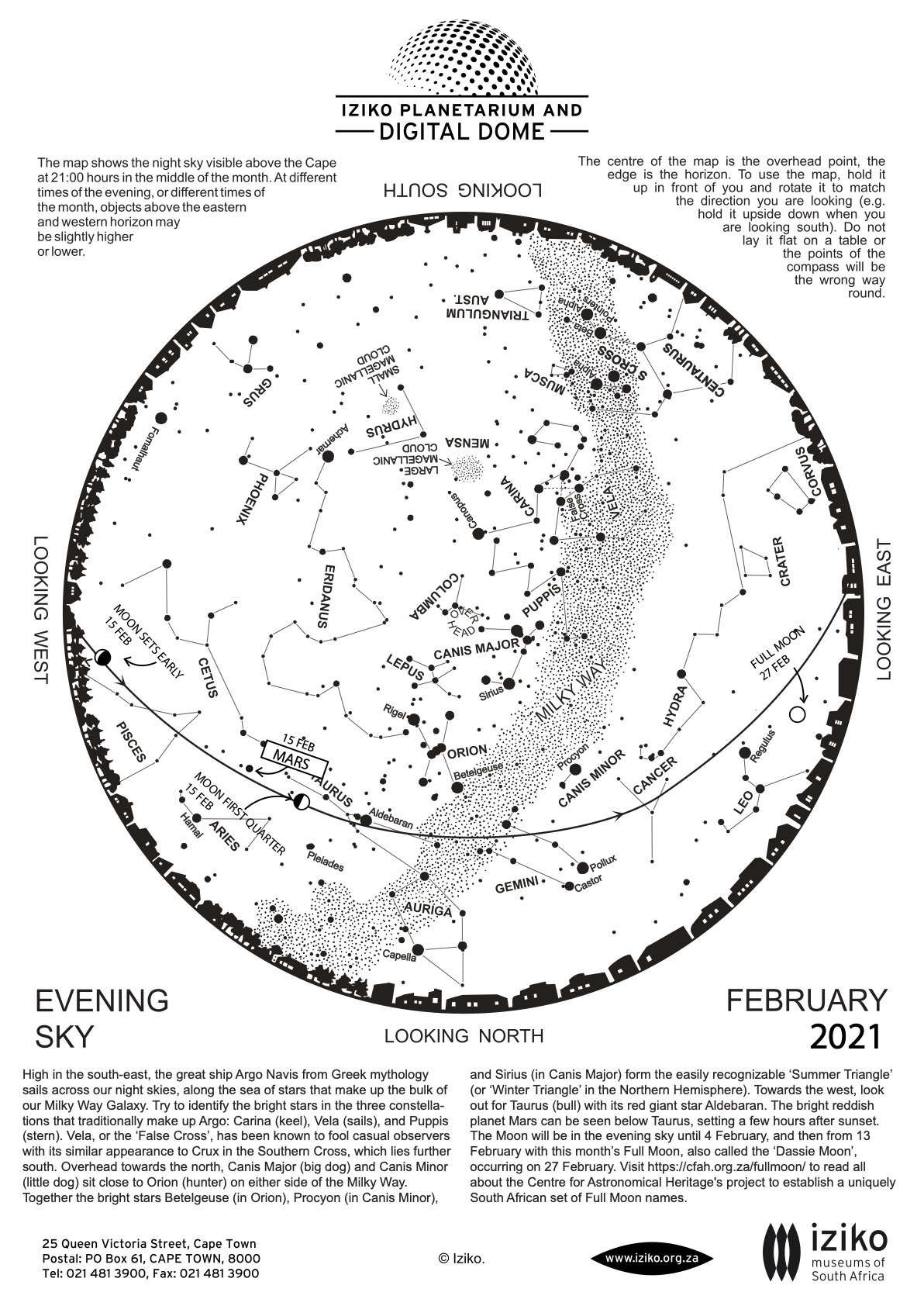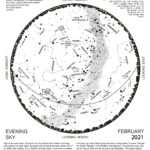
01 Feb Whats Up – February 2021
In a nutshell…
Moon
| Date | Time | Phase |
|---|---|---|
| 04/02 | 19h37 | Last Quarter |
| 11/02 | 21h05 | New Moon |
| 19/02 | 20h47 | First Quarter |
| 27/02 | 10h17 | Full Moon |
Moon – Earth Relations
Perigee: 370 116 km on the 03/02 at 21h03
Apogee: 404 467 km on the 18/02 at 12h21
Planet Visibility
Mars (near Taurus) visible in the evening sky
Mercury, Venus, Jupiter and Saturn are visible in the morning sky, near Capricornus
Some easy to identify bright stars
Rigel: blue supergiant in Orion
Betelgeuse: red supergiant in Orion
Procyon: yellowish white star in Canis Minor
Sirius: brightest star in the night sky, located in Canis Major
Antares: red supergiant in Scorpius
Arcturus: red giant in Boötes
Spica: brightest bluish-white star in Virgo
Canopus: yellowish-white star in Carina
Altair: a white star, brightest in Aquila
Regulus: blue–white star and the brightest star in Leo
The Pointers: Alpha and Beta Centauri
Sun and Moon
The Last Quarter Moon falls on the 4th of February at 19h37. The New Moon occurs on the 11th February at 21h05 and the First Quarter Moon will fall on the 19th of February at 20h47. The Full Moon occurs on the 27th of February at 10h17.
On the 18th of February at 12h21 the Moon will be at apogee (furthest from Earth) at a distance of 404 467 km. The Moon will be at perigee (closest approach to Earth) at a distance of 370 116 km on the 3rd of February at 21h03
Planetary and Other Events – Morning and Evening
Four of the bright planets (Mercury, Venus, Jupiter and Saturn) will be visible in the morning sky during this month. Only Mars is visible in the evening sky.
Mars, the red planet is well located for observation in the evening sky. It Is near the stars of the constellation Aries in the beginning of the month and is near the constellation Taurus from the second week till the end of the month. The Moon will be near Mars on the 18th of February.
Mercury is closer to the Sun at the beginning of this month, making it extremely difficult to observe in the western horizon. Mercury reaches inferior conjunction on the 8th of February and is visible in the morning sky near the stars of the constellation Capricornus. Venus, the hottest planet in our solar system, is well placed for observation in the south eastern horizon in the morning skies just before sunrise. Venus will be near the Moon and Jupiter on the 10th and near Saturn on the 11th of February. Do not miss out on the Moon, Saturn and Venus alignment on the 10th just before sunrise. Catch the exciting Saturn, Mercury and Jupiter alignment from the 16th to the last day of this month before sunrise!
Two meteor showers are active in February. The gamma-Normids are active from February the 25th to March the 22nd, peaking on the 13th of March. To see the shower, look towards the constellation of Norma between 00:00 AM and 04:00 AM. Around 8 meteors per hour are expected at the peak.
The alpha Centaurids in the constellation of Centaurus are active from the 28th January to the 21st February, peaking on the 8th of February as the Earth passes through the centre of the meteor stream. Observing prospects for the alpha Centaurids are unfavorable due to the full moon on the 4th. They are best viewed between 22:00 PM and 03:30 AM looking towards the constellation of Centaurus in the South East. Hourly rates are expected to be around 7 meteors per hour at the maximum.
The Evening Sky Stars
The stars of Orion are high in the north on February evenings, with blue-white Rigel above and to the left of the three belt stars, and orange-red Betelgeuse below and to the right of them. Below and to the left of Orion is Aldebaran, brightest star in the Bull, with the Pleiades nearby in the NW at the Bull’s shoulder. The Pleiades, according to the Namaquas, were the daughters of the sky god. When their husband (Aldebaran) shot his arrow (Orion’s sword) at three zebras (Orion’s belt), it fell short. He dared not return home because he had killed no game, and he dared not retrieve his arrow because of the fierce lion (Betelgeuse) which sat watching the zebras. There he sits still, shivering in the cold night and suffering thirst and hunger.
To the right of Orion is Procyon, brightest star in the smaller of Orion’s two hunting dogs. Directly below (N) of Procyon are the stars of the Twins, with the dim stars of Cancer the Crab just to the right. Among the stars of Cancer is what looks to the eye like a fuzzy glow, but which binoculars show to be a cluster of stars, the ‘Beehive’. Directly below Orion is brilliant Capella near the northern horizon, brightest star in the Charioteer. Capella is actually a system of four stars, consisting of a pair of luminous yellow stars and a pair of faint red dwarf stars. Above Orion’s feet (he’s upside down, as you’d expect for a constellation invented in the northern hemisphere) is the Hare, with Orion’s Big Dog above Orion itself and to the right if you’re facing north. The Big Dog boasts the brightest star in the night sky, Sirius.
With Sirius nearly overhead, we have Canopus (second brightest star in the sky) high in the south near the Milky Way. Bright Achernar (Senakane, the ‘Little Horn’) is below Canopus and to the right for an observer facing south. The Water Snake and the Small Magellanic Cloud are below Achernar and to the left. Among galaxies separate from our own, the Small Magellanic Cloud is the second nearest, ‘only’ 200 000 light years away. We see it as a dim glow like a detached piece of the Milky Way — and we see it as it was 200 000 years ago. This small satellite galaxy of the Milky Way is gradually being torn apart by the tidal forces it encounters each time it passes near our Milky Way’s largest satellite galaxy, the Large Magellanic Cloud.
This time of year is a great time for snakes in the sky. The Small Magellanic Cloud lies partly in the southern Water Snake, while the giant monster Water Serpent is visible in the north. Directly to the right of Achernar are the stars of the Phoenix, with the Toucan directly below. The Toucan includes a particularly beautiful cluster of hundreds of thousands of stars, just visible to the naked eye as a dim fuzzy spot if there is no moon and there are no city lights interfering. This cluster, 47 Tucanae, is nearly 120 light years across, and is roughly 20 000 light years away from us. Of the roughly 100 ‘globular clusters’ that orbit the centre of our Milky Way galaxy, 47 Tuc is the second brightest.
The Milky Way runs almost due north and south in our skies in early evening this month, from the N into the SSW. The southern portion is very much the brighter, running through the constellations of the Poop Deck, the Compass, the Sails and the Keel (all parts of the ancient constellation of the great ship Argo), with Crux and the Centaur near the horizon.
Rising into eastern evening sky this month are Alphard, the orange star at the heart of Hydra the Water Serpent (lowest in the east at dusk), and Regulus in Leo (low in the northeast).
The Morning Sky Stars
The brilliant Milky Way in the morning sky runs from E to WSW, running from Scutum (the Shield), the Archer and the Scorpion through the Carpenter’s Square, the Altar, the Wolf and the Drawing Compasses, before reaching the Centaur, the Cross and the Housefly, and finally the Great Ship Argo in the west. To the south of the Milky Way are the mostly dim stars of the Peacock, the Bird of Paradise, the Octant, the Chameleon and the Flying Fish.
High in the north, almost overheard, are the stars of Virgo, with blue-white Spica the brightest among them. Spica is actually a double star but unfortunately it is not resolvable with binoculars or a telescope. The two components are less than 32 million kilometres apart (the Sun-Earth distance is 150 million kilometres). The two stars orbit each other every 4 days.
Keeping dangerous bears out of our southern sky is bright orange Arcturus, low in the north and brightest star in the constellation of Boötes, the bear-herd. Arcturus is the brightest star in the sky’s northern hemisphere and the fourth brightest in the sky. Arcturus is cooler and much larger than our sun, radiating more than 200 times as much energy. At 26 times our sun’s diameter, Arcturus would extend a quarter of the way out to the planet Mercury if put in the Sun’s place. Unlike the Sun, it does not derive its energy output from fusing hydrogen to helium in its core, but has reached a stage in its life cycle where it converts helium into carbon.
Sivuyile Manxoyi
sivuyile@saao.ac.za
The evening sky over Cape Town
The evening sky over Johannesburg


